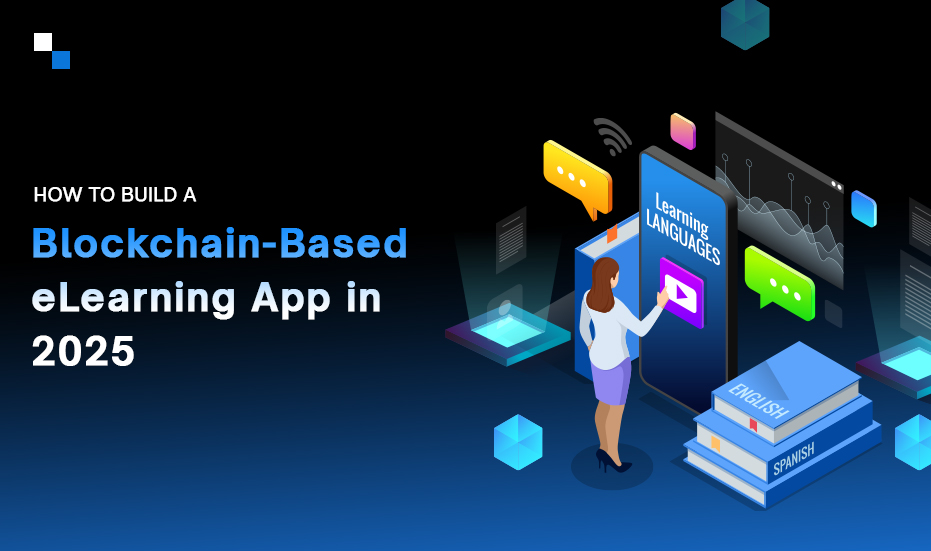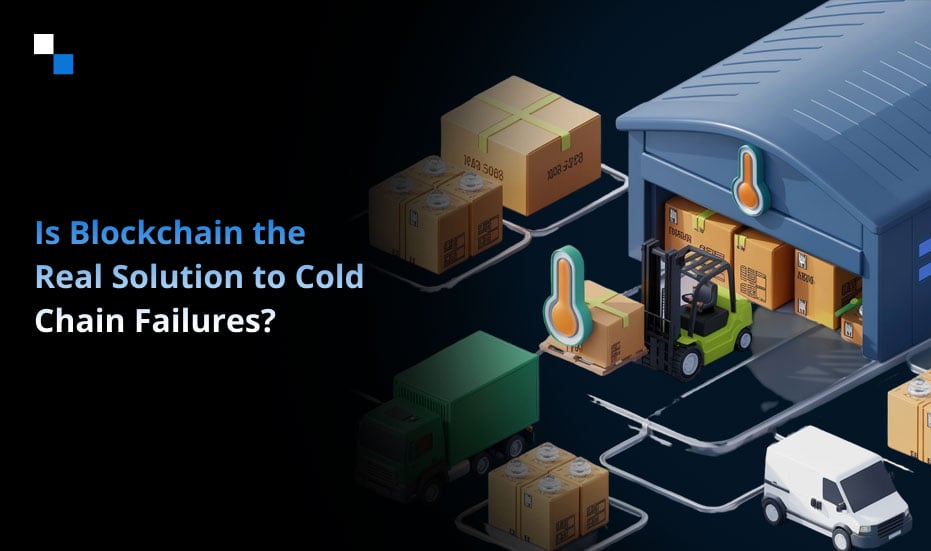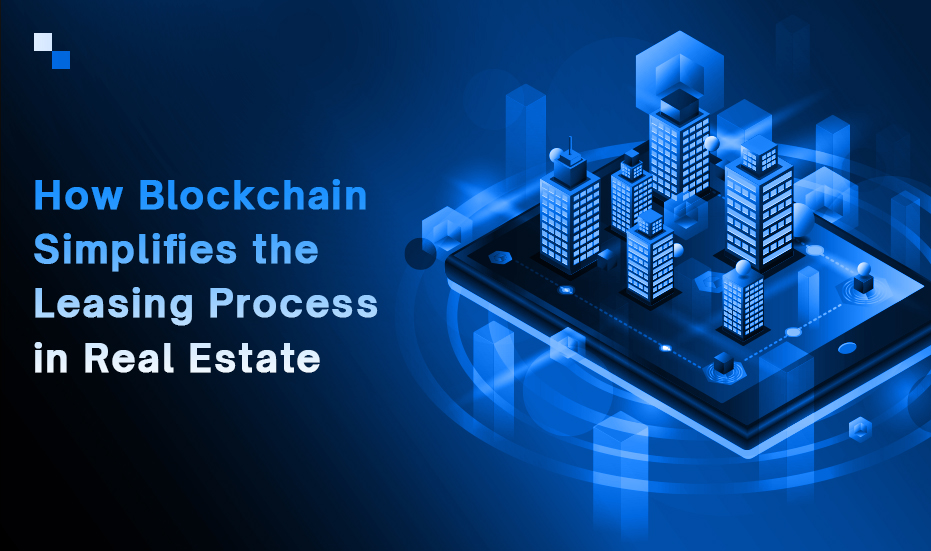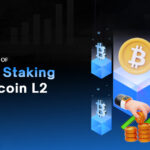The global eLearning market is booming, expected to surpass $400 billion by 2026, and with the rise of digital transformation, businesses are looking for more secure, transparent, and efficient education platforms. If your business is aiming to ride the next wave of education technology, it’s time to ask: Is your eLearning platform future-ready? If not, it’s high time to invest in the blockchain.
The decentralized and secure nature of blockchain in eLearning reshapes the way learners and institutions interact. Blockchain addresses the shortcomings of existing eLearning apps and makes it an efficient, transparent, and trustworthy ecosystem for knowledge sharing and credential verification.
In this guide, we’ll walk you through everything you need to know about blockchain eLearning app development in 2025. Whether you’re an edtech startup, a corporate training provider, or a university seeking cutting-edge solutions, this is your ultimate roadmap.
Why Blockchain in eLearning Is Gaining Ground
Before diving into the development process, it’s crucial to understand the “why.” Why are businesses increasingly investing in blockchain-based education solutions?
According to a report by Business Research Insights, the global blockchain in the education market was USD 0.35 billion in 2024 and is expected to reach USD 9.39 billion by 2033, growing at a CAGR of over 43.94%.

The growth of blockchain in the global education market
This rapid growth is driven by:
- A rising need for secure digital certificates
- Demand for lifelong learning records
- A surge in remote education models
- Increased focus on skill-based hiring
All these factors have opened the door for several blockchain use cases in education, spanning across multiple areas, ranging from issuing tamper-proof digital certificates and maintaining immutable academic records to building decentralized learning management systems and simplifying credential verification processes. These innovations not only enhance learner experience but also enable institutions to eliminate intermediaries and cut costs.
Step-by-Step Process of Blockchain eLearning App Development
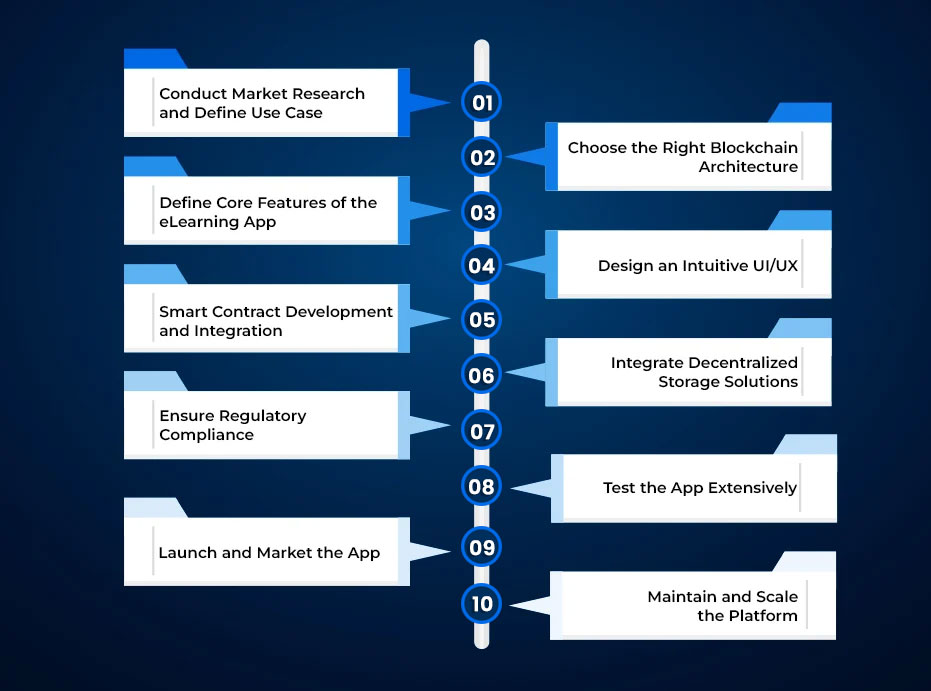
Step 1: Conduct Market Research and Define Use Case
Start with a clear understanding of the specific blockchain use cases in education you aim to address. Is your app targeting credential verification, course content distribution, decentralized learning, or student data management?
Questions to consider:
- What pain points does your platform solve for learners or educators?
- How does blockchain provide a better solution than traditional tech stacks?
- Who are your competitors and what are their weaknesses?
Market research also helps define the regulatory requirements, user demographics, and regional compliance needs of your app.
Step 2: Choose the Right Blockchain Architecture
Selecting the right blockchain type (public, private, or consortium) is crucial. For example:
- Public blockchains like Ethereum are suitable for open educational ecosystems.
- Private blockchains are ideal for institutions seeking tighter access control.
- Consortium blockchains enable collaboration among multiple schools or universities.
During blockchain eLearning app development, it is crucial to select a blockchain platform that aligns with the project’s scalability, security, and cost-efficiency requirements.
Step 3: Define Core Features of the eLearning App
An efficient blockchain eLearning application should support the following core features:
- User registration and identity verification (linked to decentralized IDs)
- Course content management (stored on InterPlanetary File System or other decentralized storage)
- Smart contract integration for automated tasks
- Secure payment gateway supporting crypto and fiat currencies
- Credential issuance and verification via NFTs or digital certificates
- In-app communication tools such as forums or chatbots
Integrating these core features will help develop blockchain eLearning applications that offer a seamless learning experience for both learners and educators.
Step 4: Design an Intuitive UI/UX
Despite the complex backend technology, the front end of the blockchain eLearning app must be user-friendly and intuitive. A seamless user experience helps retain learners and educators. Some UI/UX best practices include:
- Clean navigation and dashboard design
- Mobile-first responsive layout
- Accessibility features for learners with disabilities
- Interactive course modules and progress tracking
Step 5: Smart Contract Development and Integration
Smart contracts are the backbone of a blockchain eLearning app. They automate:
- Enrollment processes
- Certification issuance
- Reward distribution
- Payment settlements
Proper auditing and testing of smart contracts are essential to prevent vulnerabilities. Partner with a reputed firm for developing blockchain solutions for education. Such firms possess skilled developers capable of writing secure, efficient, and reliable smart contracts tailored to the specific needs of educational platforms.
Step 6: Integrate Decentralized Storage Solutions
Course materials, student records, and certifications should be stored using decentralized systems like IPFS, Filecoin, or Arweave. This ensures data immutability and resistance to tampering or unauthorized access.
Pairing decentralized storage with blockchain creates a truly distributed eLearning ecosystem..
Step 7: Ensure Regulatory Compliance
Data privacy laws must be factored into your app’s architecture. During blockchain eLearning app development, implement strong encryption standards, data ownership controls, and audit trails.
Also consider:
- Local laws around crypto payments
- KYC/AML requirements for user onboarding
- Accessibility and anti-discrimination policies
Compliance builds trust among users and strengthens your business’s reputation in the market.
Step 8: Test the App Extensively
Before launching, conduct thorough testing across all components:
- Functional testing: Ensure smart contracts and app features work correctly.
- Security testing: Identify potential vulnerabilities in blockchain and off-chain components.
- Performance testing: Check app speed, transaction throughput, and scalability.
- User testing: Collect feedback from actual educators and students.
Testing is an integral part of successful blockchain eLearning app development as it ensures the platform performs optimally under real-world conditions.
Step 9: Launch and Market the App
Once your app is ready, launch it through relevant app stores and web platforms. Marketing efforts should target:
- Educational institutions and training providers
- EdTech companies and content creators
- Governments and certification bodies
Consider publishing whitepapers, running webinars, and leveraging ad campaigns to promote your platform.
Step 10: Maintain and Scale the Platform
Post-launch support includes:
- Regular feature updates
- Security patches
- User feedback integration
- Infrastructure scaling
As user adoption grows, consider adding AI integration, multi-language support, and data analytics dashboards to improve the learning experience.
Also, explore partnerships with universities and certification authorities to expand your app’s credibility and user base.
Business Benefits of Blockchain eLearning App Development
Why should your business invest in blockchain eLearning app development right now? Here are just a few competitive advantages:

-
Faster Credential Verification
Blockchain automates the critical process of credential verification and eliminates the manual intervention that often becomes the cause of errors. This automation in the verification process saves time, significantly lowers administrative workload, and speeds up onboarding for employers, institutions, and learners.
-
Global Access to Certified Education
Another benefit of utilizing blockchain in eLearning is that such solutions also ensure secure, borderless access to verified learning content and certifications. It enables institutions to reach international audiences and provides learners worldwide access to trusted education without location-based limitations.
-
Decentralized Ownership
Learners trusting blockchain in eLearning also get the ease to control their academic records through blockchain’s decentralized model. They experience increased transparency with no third-party manipulation that further builds user confidence in the authenticity and permanence of their credentials.
-
Cost Savings on Fraud Prevention
Immutable records and tamper-proof digital certificates embedded within blockchain-based eLearning solutions act as a powerful deterrent against forgery and duplication, common challenges that often lead to significant financial losses for institutions and organizations. With blockchain eLearning application development, businesses can move towards building an ecosystem defined by trust, security, and operational efficiency.
-
New Monetization Models via Tokens/NFTs
Blockchain enables token-based economies, where learners earn or spend tokens and creators monetize content via NFTs. It introduces innovative revenue streams and engagement strategies for eLearning platforms and educators.

Industries That Can Leverage Blockchain eLearning Apps
This trend isn’t limited to universities or edtech startups. A wide range of industries can benefit from blockchain eLearning apps, including:
-
Corporate training platforms
Companies can use apps using blockchain in eLearning to train employees, track progress, and give certificates that can’t be faked or lost.
-
Healthcare institutions
Hospitals can use these apps to train doctors and nurses, and keep records of their certifications safely and clearly.
-
Government education programs
Governments can use blockchain solutions for education to offer online courses and show how funds are used, track student success, and give trusted certificates.
-
NGOs and nonprofits
Nonprofits can teach people in remote areas through blockchain apps and provide free, secure, and verifiable education without needing big systems.
-
Professional associations
Groups like law or medical boards can give digital certificates that are safe, easy to share, and can’t be changed or copied.The potential is massive, and early adopters are already gaining a competitive edge.
Final Thoughts
By now, you’ve got a solid grasp of how to approach blockchain eLearning app development, from ideation to launch and beyond. We’ve covered the top blockchain use cases in education, key development phases, smart contract creation, token integration, and the business upside. But here’s the real question: Who’s going to build it for you? That’s where Antier steps in.
As a global leader in blockchain development for education, Antier specializes in creating custom eLearning platforms that are secure, scalable, and future-ready. With deep experience in smart contract development, token engineering, and education system integration, we empower organizations to stay ahead of the curve. We focus on crafting blockchain-powered education ecosystems that redefine how learners connect, grow, and succeed. Ready to future-proof your learning platform?
Get in touch with our team to explore how our blockchain solutions can transform your vision into a high-performing product.
